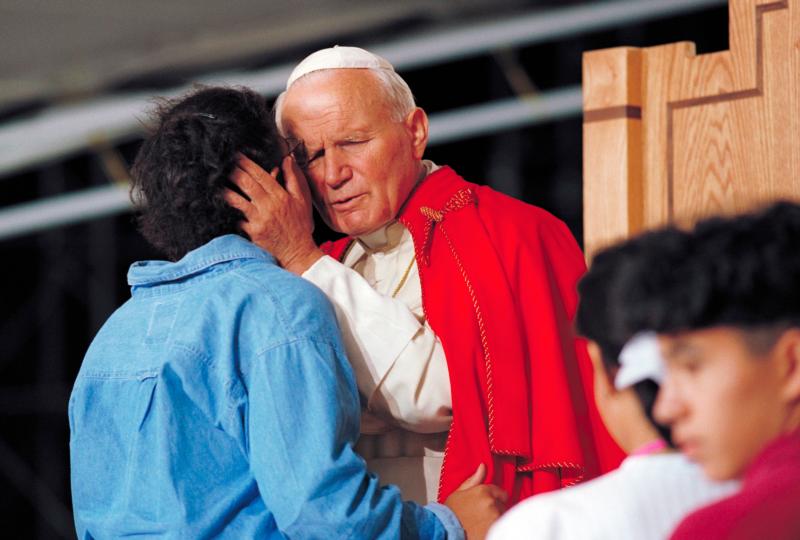
St. John Paul II embraces a young woman during the closing Mass of World Youth Day in Denver in 1993. (CNS photo/Joe Rimkus Jr.)
The world makes its way, for better or worse, into our still-young, new millennium. But time flies! Nearly 20 years of this millennium’s first century already have assumed their place in history’s annals.
Great hopes accompanied the millennium’s arrival. Could ways be found in the age ahead to make the kind of human progress that genuinely advances lives — progress that reaches deeper than simply multiplying “things that people can use,” as St. John Paul II put it?
(See a related video.)
About 20 years before the millennium’s arrival, in 1979 to be precise, the newly elected Pope John Paul II posed such a question. His first encyclical, “The Redeemer of Man” (“Redemptor Hominis”), called the world’s attention to the coming of the year 2000, which he considered “already very close.”
Laying out his vision for a new era, he wondered what mark it might “leave on the face of human history” (No. 1). Could it serve among Christians as an opportunity to reawaken awareness of all it implies to believe that “the Word became flesh and made his dwelling among us” (Jn. 1:14)?
[hotblock]
St. John Paul hoped beyond hope that in this era Christ’s followers would realize with new clarity that “by his incarnation” God’s Son “in a certain way united himself” with every human person and became “one of us” (No. 8). But Christ’s incarnation is not about him only. The pope said that “in Christ and through Christ man has acquired full awareness of his dignity” and “surpassing worth” (No. 11).
The encyclical spoke of human dignity more than a dozen times, and this became a theme of a lengthy papacy, which continued until 2005.
His encyclical spoke, the pope explained, of “the mystery in which each one” of the Earth’s billions of people becomes “a sharer from the moment he is conceived.” It spoke, moreover, of each one’s “unique, unrepeatable human reality” (No. 13).
In St. John Paul’s eyes, the new millennium would arrive bearing an invitation not just to recognize everyone’s human dignity, but to act upon that recognition by serving others “worthily and effectively” (No. 21).
When the new millennium arrived, he expanded upon these points in an apostolic letter titled “At the Beginning of the New Millennium” (“Novo Millennio Ineunte”) for the close of the church’s Jubilee of the Year 2000. “We need to remember that no one can be excluded from our love, since ‘through his incarnation the Son of God has united himself in some fashion with every person,'” it insisted.
The pope wrote, “The century and the millennium now beginning will need to see … to what length of dedication the Christian community can go in charity toward the poorest.” He added, citing the Gospel of Matthew (25:35-36):
[tower]
“If we truly have started out anew from the contemplation of Christ, we must learn to see him especially in the faces of those with whom he himself wished to be identified (when he said): ‘I was hungry and you gave me food, I was thirsty and you gave me drink, I was a stranger and you welcomed me, I was naked and you clothed me.'”
That passage “is not a simple invitation to charity,” the pope wrote as the new millennium began. It “sheds a ray of light” on who Christ is. And “by these words, no less than by the orthodoxy of her doctrine, the church measures her fidelity as the bride of Christ.”
St. John Paul’s 1979 encyclical envisioned a vast Christian mission of concerned care for humanity. Not humanity as a generality, however, but unique people with problems, hopes, failures and achievements.
A “deep amazement at man’s worth and dignity” permeates Christianity, the encyclical affirmed, an amazement that “determines the church’s mission in the world” (No. 10).
St. John Paul was convinced that “because Christ united himself with her in his mystery of redemption,” the church must be united strongly with every person (No. 18).
***
Gibson served on Catholic News Service’s editorial staff for 37 years.
PREVIOUS: ‘Redeemer of man,’ the vision and agenda of St. John Paul II’s papacy
NEXT: St. John Paul II: A pope for modern man and an eternal God



Share this story